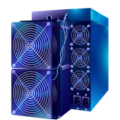MicroBT WhatsMiner M60
WhatsMiner M60 spostrzeżenia na temat rentowności zasilane danymi w czasie rzeczywistym: Odkryj, ile wart jest twój WhatsMiner M60 Możesz zarobić korzystając z naszego zaawansowanego kalkulatora ASIC miner. Używamy danych o nagrodach za wydobycie na żywo i automatycznie uwzględniamy koszty energii, dając Ci przejrzysty przegląd potencjalnych dziennych, miesięcznych i rocznych zysków.
Analiza rentowności
Tutaj możesz zobaczyć szczegółową analizę opłacalności minera, aktualizowaną w czasie rzeczywistym.
| Okres | Dochód | Wydatek | Zysk |
|---|---|---|---|
|
Codziennie
|
$7.80 | $6.57 |
$1.23
|
|
Miesięczny
|
$234.01 | $197.11 |
$36.90
|
|
Rocznie
|
$2,847.09 | $2,398.14 |
$448.95
|
O wydobyciu MicroBT WhatsMiner M60 (172TH/s)
Dowiedz się więcej o tym koparce ASIC, w tym o jej specyfikacjach, wydajności, zużyciu energii i rentowności.
The MicroBT WhatsMiner M60 is a purpose-built SHA-256 ASIC for Bitcoin-class workloads, delivering 172 TH/s at 3,422 W for an efficiency of roughly 19.9 J/TH, and it marries that performance to a clear-eyed engineering package: advanced 5 nm chips, a dual-fan front-to-back air path, and reinforced hardware that sustains stable output under continuous duty. In practice, that means predictable thermal behavior, fewer throttling events, and more consistent uptime, even as ambient conditions fluctuate. With a noise level around 75 dB, it is squarely an industrial-grade unit, best placed in managed facilities with dedicated airflow and dust control. Its compact 430 x 155 x 226 mm chassis and 13.5 kg weight simplify rack planning and dense deployments, while optimized power distribution helps curb waste and keep energy use close to the theoretical envelope. For planning and operations, the numbers are concrete: a steady 3.422 kW draw equates to about 82.1 kWh per day, roughly 2,463.8 kWh per 30-day month, and about 29,976.7 kWh per year, making site readiness, heat extraction, and electrical capacity non-negotiable considerations. Profitability hinges on the familiar variables-network difficulty, pool fees, uptime, and your electricity rate-so a real-time mining calculator tied to current network data can translate hashrate and energy use into projected daily, monthly, and annual outcomes, while sensitivity checks (for example, modest swings in difficulty or fee structures) help you gauge risk. In short, the M60 is engineered for high-performance, round-the-clock mining, balancing throughput and efficiency in a form factor that rewards careful thermal design, routine maintenance of fan intakes and exhaust paths, and disciplined power provisioning.
Odkryj, które monety może wydobywać ten górnik
Zbadaj kryptowaluty, które można wydobywać przy użyciu MicroBT WhatsMiner M60 (172TH/s), z szczegółową rentownością.
Kantor Walutowy
Oblicz coiny do wydobycia w dowolnej walucie.
| Moneta | Dochód/Dzień | Zysk/Dzień |
|---|---|---|
|
$7.27
$
0.00007146

|
$0.70
$
0.00000684

|
|
|
$7.32
$
0.00007180

|
$0.75
$
0.00000734

|
|
|
$7.16
$
0.01411491

|
$0.59
$
0.00117066

|
|
|
$7.80
$
19.48

|
$1.23
$
3.08

|
Historyczna wydajność kopania
Zobacz trendy wydajności MicroBT WhatsMiner M60 (172TH/s) w ramach okresów tygodniowych, miesięcznych i rocznych.
Historyczna rentowność
Zobacz historyczne dochody i trendy zysku dla tego górnika.
SHA-256 Generacje Minerów
Ewolucja sprzętu do kopania kryptowalut na przestrzeni lat, z wyróżnieniem obecnej generacji dla odniesienia.
Generacja 1
26 GórnicyGeneracja 2
26 GórnicyGeneracja 3
26 GórnicyGeneracja 4
26 GórnicyGeneracja 5
26 GórnicyGeneracja 6
26 GórnicyGeneracja 7
27 GórnicyGeneracja 8
27 GórnicyGeneracja 1
26 GórnicyGeneracja 2
26 GórnicyGeneracja 3
26 GórnicyGeneracja 4
26 GórnicyGeneracja 5
26 GórnicyGeneracja 6
26 GórnicyGeneracja 7
27 GórnicyGeneracja 8
27 GórnicyWięcej informacji na temat
Dowiedz się więcej o MicroBT WhatsMiner M60 (172TH/s)
Housed in an alloy shell that remembers its own heat and gives it back to the air with orderly grace, the MicroBT WhatsMiner M60 is an SHA-256 machine built for Bitcoin that pushes about 172 TH/s from advanced 5 nm silicon while drawing near 3.422 kW, yielding roughly 19.9 J/TH, and its design tends to the long march of uptime: a dual PWM fan, front-to-back path drives flow across high-efficiency heat sinks, the noise settling around 75 dB, while the upgraded power management unit apportions current like a careful steward to keep hashrate steady when line conditions ripple; dynamic frequency scaling trims or advances clocks to match the electrical and thermal moment, so throttling is measured rather than abrupt, and integrated voltage regulation shields the ASICs from stress that ages lesser boards. The firmware’s AI-based fault detection reads hashboard behavior and flags irregularities early, pairing with watchdog recovery, per-chain auto-tune, and a straightforward web console for pool setup over standard Ethernet and Stratum; operators can watch inlet and outlet temperatures, fan RPM, voltage rails, and share error rates the way a navigator keeps an eye on wind and tide, making small corrections before they become storms. Sized for density at about 430 x 155 x 226 mm and roughly 13.5 kg, the unit fits cleanly in racked rows; plan for a clean, cool intake and a clear exhaust vector, with pre-filters to tame dust without starving airflow, and schedule light vacuuming of intakes and periodic fan health checks rather than aggressive compressed air bursts that drive particulates deeper. In typical facilities, a 200–240 V AC, 50/60 Hz feed with high power factor and good grounding keeps harmonics modest and the PMU untroubled; at these voltages expect around 14–17 A per unit under steady load, so derate circuits sensibly, balance phases where applicable, and leave margin for startup and thermal excursions. Ambient best practice sits near 5–35°C with non-condensing humidity; keep an eye on altitude, since thinner air dulls cooling and the fans will chase the deficit; a small delta between inlet and outlet temperatures signals good ducting and a clean path. For industrial placements, treat the acoustic profile with ducting or muffling and consider hearing protection for nearby staff; in light commercial rooms, isolate the intake from the warm aisle to avoid recirculation and heat soak. Reliability lives in little habits: validate firmware signatures before updates, keep a spare fan and a known-good Ethernet cable on hand, log rejected shares and voltage sags, and retire dust-laden filters before they strangle the flow; should something go astray, the miner’s diagnostics and auto-recovery routines tend to land rather than crash, preserving work while you swap a fan, reseat a cable, or recalibrate a chain. In the ledger of planning, remember the constants-stable power, directed airflow, routine cleaning, and disciplined monitoring-and the M60’s balanced engineering will make the familiar hum of 24/7 hashing sound like a promise kept.
Gdzie kupić?
Zaufani dostawcy i aktualna dostępność na rynku, prezentujący zweryfikowanych dostawców oferujących ten miner ASIC wraz z najnowszymi informacjami o cenach i zapasach.
Brak dostępnych ofert
Aktualnie nie ma ofert dla tego minera. Proszę sprawdzić później.
Specyfikacje techniczne
Szczegółowe specyfikacje sprzętu i możliwości wydobywcze dla MicroBT WhatsMiner M60
Podstawowe informacje
Performance
Physical Dimensions
Kryptowaluty Możliwe do Wydobycia



Algorytm Informacje: SHA-256
Dowiedz się więcej o SHA-256 algorytm i jak to działa.
SHA-256 jest funkcją haszującą, która służy jako podstawa Fractal Bitcoin mechanizm konsensusu proof-of-work. Ten algorytm przetwarza dane wejściowe o dowolnej długości i produkuje stałą wartość hasha, zapewniając bezpieczeństwo i integralność w procesie wydobywania.
Pule wydobywcze kryptowalut
Połącz się z najbardziej niezawodnymi pulami wydobywczymi i zmaksymalizuj swoją efektywność wydobycia kryptowalut dzięki zoptymalizowanej dostępności i rentowności.
Opinie użytkowników
Zobacz, co użytkownicy mówią o tym minerze.
Brak recenzji
Bądź pierwszym, który oceni tego minera!
Najczęściej zadawane pytania
Wszystko, co musisz wiedzieć o MicroBT WhatsMiner M60
Jak efektywny jest MicroBT WhatsMiner M60 172TH/s?
Jakie są koszty energii elektrycznej dla MicroBT WhatsMiner M60 172TH/s (USD)?
Ile mocy zużywa MicroBT WhatsMiner M60 172TH/s ?
Kto produkuje WhatsMiner M60?
Jaki jest hashrate MicroBT WhatsMiner M60?
Jakie kryptowaluty można wydobywać za pomocą MicroBT WhatsMiner M60 172TH/s?
 NiceHash (BTC)
NiceHash (BTC)
 Bitcoin (BTC)
Bitcoin (BTC)
 Bitcoin Cash (BCH)
Bitcoin Cash (BCH)
 Fractal Bitcoin (FB)
Fractal Bitcoin (FB)
Czy jest MicroBT WhatsMiner M60 172TH/s opłacalny górnik?
To sprawia, że MicroBT WhatsMiner M60 172TH/s opłacalny wybór dla kopania.
 Angielski
Angielski
 Niemiecki
Niemiecki
 Węgierski
Węgierski
 Holenderski
Holenderski
 Hiszpański
Hiszpański
 Francuski
Francuski
 Włoski
Włoski
 Czeski
Czeski
 Polski
Polski
 Grecki
Grecki
















